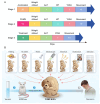TAK-653 Reverses Core Depressive Symptoms in Chronic Stress-Induced Monkey Model
- PMID: 40564108
- PMCID: PMC12189935
- DOI: 10.3390/biomedicines13061389
TAK-653 Reverses Core Depressive Symptoms in Chronic Stress-Induced Monkey Model
Abstract
Background: Major Depressive Disorder represents a prevalent and critical mental health issue that highlights the pressing need for innovative therapeutic solutions. Recent research has identified dysfunction within the glutamate system as a crucial element influencing both the onset and management of depressive symptoms. Although TAK-653 is a new positive allosteric modulator of AMPA receptors, its effects have not been rigorously examined in models of depression in primates. Methods: To assess its potential antidepressant properties, a chronic unpredictable mild stress protocol was implemented over 12 weeks to create a monkey model of depression, followed by a two-week treatment period with TAK-653. Results: Behavioral evaluations showed that following stress exposure, the monkeys exhibited reduced motivation for food, increased huddling, diminished movement, and a tendency to remain at the lower levels of their enclosure. They also displayed heightened anxiety in response to external stimuli. Plasma analyses indicated higher levels of cortisol, IL-6, and IL-8 in the stressed monkeys compared to baseline readings, confirming the efficacy of the stress-inducing protocol. Post-treatment with TAK-653 resulted in significant improvements, such as enhanced motivation for food, less huddling behavior, greater activity, and a move towards the upper areas of the enclosure. Additionally, the plasma analysis revealed a marked decrease in cortisol and IL-6 levels, along with an increased expression of BDNF. Conclusions: These findings indicate that TAK-653 effectively alleviates depression-like behaviors in nonhuman primate models, thereby paving the way for a promising new strategy in the treatment of depression.
Keywords: TAK-653; chronic unpredictable mild stress; cytokines; major depressive disorder; monkey.
Conflict of interest statement
The authors declare no conflicts of interest.
Figures




References
-
- Zhang G., Li L., Kong Y., Xu D., Bao Y., Zhang Z., Liao Z., Jiao J., Fan D., Long X., et al. Vitamin D-binding protein in plasma microglia-derived extracellular vesicles as a potential biomarker for major depressive disorder. Genes Dis. 2024;11:1009–1021. doi: 10.1016/j.gendis.2023.02.049. - DOI - PMC - PubMed
-
- Su T.P., Chen M.H., Li C.T., Lin W.C., Hong C.J., Gueorguieva R., Tu P.C., Bai Y.M., Cheng C.M., Krystal J.H. Dose-Related Effects of Adjunctive Ketamine in Taiwanese Patients with Treatment-Resistant Depression. Neuropsychopharmacology. 2017;42:2482–2492. doi: 10.1038/npp.2017.94. - DOI - PMC - PubMed
Grants and funding
- 32371066/National Natural Science Foundation of China
- 2022A1515010134/Guangdong Basic and Applied Basic Research Foundation
- NYKFKT2019009/Shenzhen-Hong Kong Institute of Brain Science-Shenzhen Fundamental Research Institutions
- XMHT20220104005/Shenzhen Technological Research Center for Primate Translational Medicine
- 2022A1515110598/Guangdong Basic and Applied Basic Research Foundation
LinkOut - more resources
Full Text Sources
Miscellaneous

